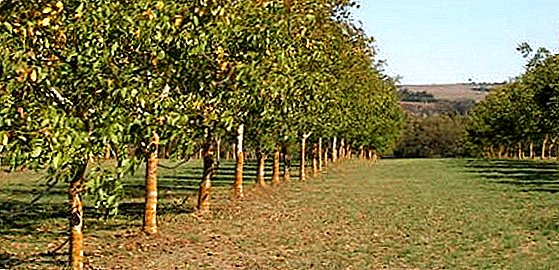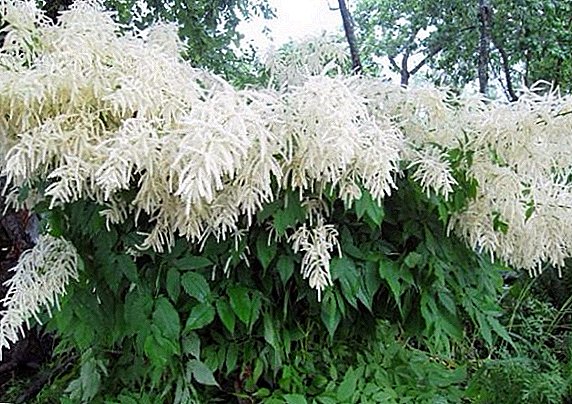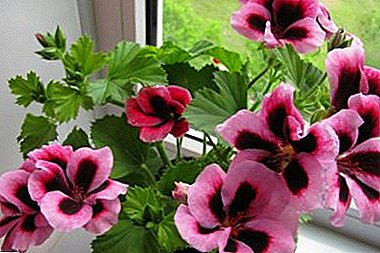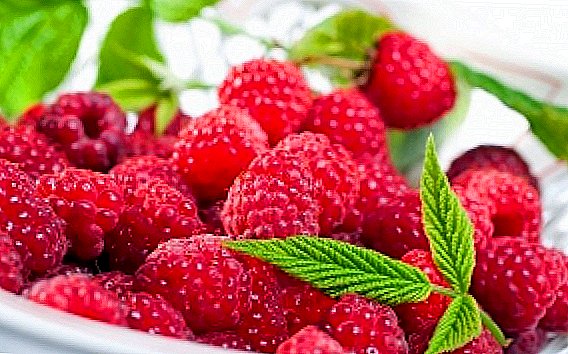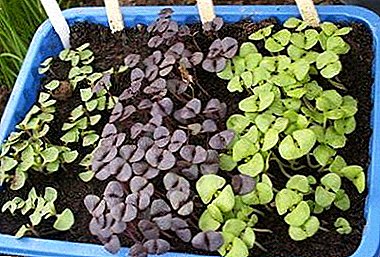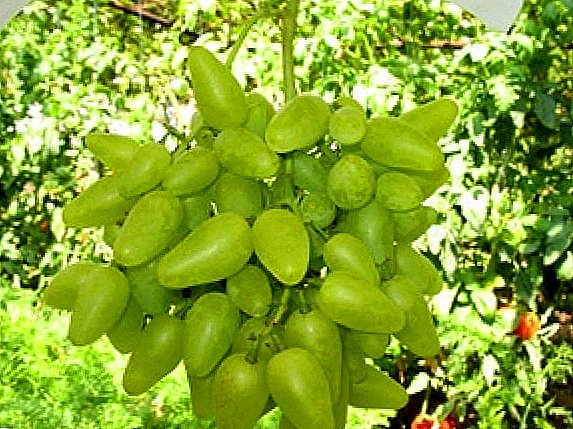
Whatever the grape, varietal or hybrid form, this is in no way evidence of the quality of its fruits and the merits of the bush itself.
Most often, it is the hybrid forms that turn out to be much more successful, especially with amateur cultivation.
And it is for lovers that the technical characteristics of the fruits of this culture, but rather its table purpose and sustainability, play a huge role.
Below we want to introduce you to an excellent variant of grapes, which will please not only the crops, but also its other features and qualities.
To cause you even more love for him, and tell about the simplicity of planting such grapes.
Grapes "Bazhena" and its main distinguishing characteristics
Of course, for ordinary citizens, the origin of grapes is absolutely irrelevant, although it can tell a lot about real fans of this culture.
If you discuss the grapes "Bazhena", then it should be mentioned and its author - the famous breeder amateur V.V. Zagorulko, who as a result of crossing varieties "Gift of Zaporozhye" and "Arcadia" produced the described hybrid form.
Today, the popularity of this grape is very wide, it is found on both amateur sites and industrial.
The secret of such popularity lies in the taste and fertility of this dining form, the fruits of which will become a real decoration of any table. This grape is also zoned widely, which was facilitated not only by its good stability, but also by the adaptability of its seedlings.
A little about bunches of grapes "Bazhena": what is the difference and what are their main advantages

The advantage of any grape form are its clusters. In the described variety they are especially attractive and very large.
On average, the mass of one bunch can vary from 0.7 to 1.5 kilograms, which is far from being a record of “Bazheny”.
Externally, they can be distinguished by the shape features: the most common are conical or cylindro-conical brushes, sometimes even with small wings. The berries are placed on clusters of medium density.
Berries grapes "Bazhena" also deserve special attention, because they can boast a fairly large size. Their average parameters are equal to the following figures: length - 4.2 centimeters, width - 2.3. Such dimensions naturally indicate the elongated ovoid shape of these berries. They weigh in average from 10 to 15 grams.
Their peculiar and distinctive feature is the yellow color of the skin. The taste of this grape is very interesting, because along with the usual harmonious taste they have a characteristic only high-quality aroma.
The berries also have a good sweetness, since sugar accumulates in them very qualitatively. Their flesh is rather fleshy, with a high content of juice, it is very pleasant and tender when eating. It is also worth noting that the skin of these berries is very thin, therefore, eaten, does not affect the taste of grapes.
The yield of the hybrid form Zagorulko: especially the fruiting and the time of fruit harvesting "Bazheny"
It produces fruits very well, its yield is fairly stable and high. Its potential fruitfulness is also very good and includes a strong force of growth of the bush, excellent maturity of the shoots along almost their entire length, as well as the ability of the vines to form large clusters.
In general, only one bunch is formed on one shoot, but for the sake of increasing the size of the berries, some growers recommend leaving every fifth shoot fruitless, that is, rationing the harvest.
Heated around the grapes "Bazhena" independentlybecause it has a bisexual flower. Thus, he practically does not have problems with fruiting or with pea berries, except in very bad years.
The great advantage of the described form of grapes is its short time for ripening fruits.
The vegetation period of the bush "Bazheny" fully passes for 100-110 days.
In the native for this grape Poltava region consumer maturity of the berries begins by the first of August. This allows you to grow it even in regions with a climate, as in central Russia.
The list of the most important advantages of grapes "Bazhena"

- Large clusters and unique taste of berries, which gives them excellent commercial quality.
- Short ripening time.
- The strength of growth and maturation of shoots is very good.
- Good pollination due to the presence of flowers with the functions of both sexes.
- The simplicity of the reproduction of grapes of this form, the main factor of which is the excellent rooting of its cuttings.
- The good suitability of the "Bazhen" grape fruit for transportation, although the skin of its berries is very thin. Berries firmly on the stalk, do not crumble when shaking.
- The form is resistant to the main fungal diseases, which include mildew and oidium.
- Gray rot bushes are not affected.
- The ideal option for growing grapes in suburban areas and among large grape plantations.
Grapes "Bazhena" and its minuses: forewarned, so protected
It is believed that this form of grapes insufficiently resistant to low winter temperatures, although its vine is able to tolerate frost to -21ºС without damage. For this reason, the bushes of grapes "Bazhena" must be harbor for the winter, especially young bushes and seedlings. Adult bushes are covered with a film, in rare cases, shoots can be removed from the support and hide right on the ground.
Also, the bushes of this grape are not resistant to phylloxera. For this reason, they cannot be planted on their own roots in those areas where its pests have manifested themselves, if after the removal of the affected plants before this, at least 2-3 years have not passed.
Also, in case you have a desire to propagate exactly “Bazhen”, it is better to graft its cuttings to the rootstocks of resistant varieties, or to buy already grafted seedlings.
It is also interesting to read about pink grapes
How to propagate and plant vines: answers to all your questions
If you have never experienced either gardening or viticulture, it is very difficult to imagine how to propagate this crop. But in general, it will not take you much work and time. The main thing is to find out which method specifically for you will be best to propagate the grapes and in which part of your site you will plant it chastely.
How to create optimal conditions for the growth of a grape bush: choose the perfect place on your site

Like any other plant, the "Bazhena" grapes need a lot of sunlight. In the case of him, under no circumstances even those places of your site that are illuminated by the sun half a day will not work. For this reason, plant vines only on the south side, preferably behind the house, which will also serve as a bush protection from the winds.
Equally important in the matter under discussion and the terrain. The fact is that in the lowlands and the valleys often cold air flows can stagnate, which can negatively affect the stability of the vine and its productivity. Thus, try to find a place at least on a slight elevation.
In choosing the soil for grapes also need to be careful. Of course, in this regard, grape bushes are able to grow on stony soils and clay, but in both cases we can not allow the extreme edge - pure clay or pure stone.
Of course, the ideal option for this variety will be black soil, but on clay with regular top dressing and soil moisture control, good results can be achieved.
Another important aspect in the cultivation of grapes is the depth of groundwater. In the case of the described variety is best to be at a depth of about 5 meters, since the root system of this grape grows very strongly and can be washed away by them.
According to what scheme are grape bushes planted?
For each variety and grape form has its own requirements for planting them in rows. After all, each bush must be given sufficient space to feed the roots and to grow shoots. Since the "Bazhena" vine has a strong growth, it is necessary to retreat at least 5 meters when planting it in a row between bushes. Thus, not only the above prescriptions will be executed, but the bushes will not shade each other with their greens.
In the same case, if you are going to plant several rows of vines, then between them you need to make a gap of even 6 meters.
How to choose the right time for planting vines?

Together with this question it is often discussed what time of year it is best to plant grapes: in spring or autumn. In order not to hide from you any important points, we will answer in detail both of these questions.
Of great importance is whether the grapes are planted in the spring or autumn is not. Each time has its advantages and disadvantages. The dates of spring planting of grapes can be very stretched, because at this time both saplings (those that have been preserved since spring) and green (they are usually grown from cuttings, planted back in February in a pot with soil) are planted.
In the first case, the earliest spring is better, and in the second - even the first days of summer. Plus, it is spring planting that is the ability of seedlings to gain strength and gain strength in a new place for greater stability before winter frosts.
Autumn planting is usually carried out in mid-October. By this time in the nurseries of seedlings they are usually put up for sale, and also grape cuttings can be harvested independently.
Specific time needs to be selected based on the climatic conditions of your region: you do not need to plant too early, because a sapling or cutting can start growing, which is highly undesirable because of the approaching frost, but it will be too dangerous to plant this culture too late.
Planting grapes "Bazhena" with seedlings: what you need to know?

The most important point that should not be forgotten is the mandatory preparation of the pit several weeks before the direct planting of a grape seedling. Always in the pit a large amount of fertilizer is laid, which must sag at the time of planting the seedling.
In particular, 2-3 buckets of humus are laid in a pit with a depth and width of about 80 centimeters, and mineral fertilizers in small quantities (superphosphates, potash salt, nitrogen). All this is mixed with fertile soil and poured into a hole. Since in such an amount, fertilizers can damage the seedling's root system, another layer of soil needs to be poured over it, but without them.
During the sinking of fertilizers, you can do the purchase and preparation of seedlings. Especially carefully look, choosing it, you need to the roots. Their healthy color is white, in no case purchase a seedling with a damaged root system, even if the seller convinces you that she can recover in the water.
Lower the root system into the water Sapling before planting is necessary, but it is not able to revive dried roots. This is done solely to ensure that the sapling is fed with the necessary amount of moisture, which should be enough for him until he starts to independently absorb it from the soil.
When planting itself, a sapling in a pit drops only to the level of its root collar, it should not be covered by it even with the future sinking of soil.
It is necessary to bury the hole slowly and gradually, so as not to damage the root system and so that airbags do not remain near it.
For this reason, in the middle of this process, you can pour a few liters of water into the pit, which will compact the soil. Also, upon completion of planting the sapling he once again plentifully watered. Near the seedling must be drive a propso that when he grows he will not creep. It is important not to forget to cover the soil with moss or sawdust.
How is grape cutting done?

For a good grafting of grape cuttings, it is important to properly prepare him. As we have already mentioned, cuttings are harvested in the fall, by cutting them out of the vine.
The optimal length of the cutting - 2-3 eyes. The lower part of it must be cut off. But it is cut off only from two sides in order to get a wedge, which later it will sink into the split of the stock.
To prolong the vitality of the cutting, it is immersed in water and root growth stimulators before inoculation. Also often recommended wax cuttings, thanks to which the accumulated moisture lasts longer.
Preparation of the rootstock includes removing the old bush, clearing the cut-off area left after this 10-centimeter hemp, and splitting the stock itself. It is very important that this split is not deep, otherwise you can damage the entire stock.
As already mentioned, the cutting is lowered into this split and tightly clamped by tying the rootstock with a rope or durable fabric. The grafting site must be very well lubricated with the help of clay, which will retain all the properties of the cutting and stock until the time of their accretion. After that, all the same manipulations are carried out, as with only a planted seedling.
Vine Care: What Requirements and Whims Does This Plant Have?
- Grapes love moisture, which he needs for growth and for the formation of the crop. For this reason, the vine bushes need to be watered at the moment the bush enters the growing season and during the pouring of the berries. Also, do not forget about the bush in drought.
- To preserve moisture in the soil for a longer time, be sure to cover it with mulch. The latter is most often used moss or sawdust, which is already blackened.
- Fruiting vine bush necessarily need extra strength to form a crop. For this reason, it needs to be regularly fed with the help of fertilizers that were used in preparing the pit.
- Each year, be sure to prune shoots, shortening each of them by 6-8 eyes. They can be cut only during the "sleep" of the bush, that is, in the fall or very early spring. At the same time, cuttings can be harvested.
- "Bazhena" refers to covering forms, so before winter, do not forget to take care of the shelter of your bush.
- Despite the good resistance, the described grapes definitely need regular preventive spraying against diseases. They are usually held 3 times in one season, always before flowering of the bush and after. Also, you need to be attentive to the appearance of phylloxera, to carry out measures for its prevention.


